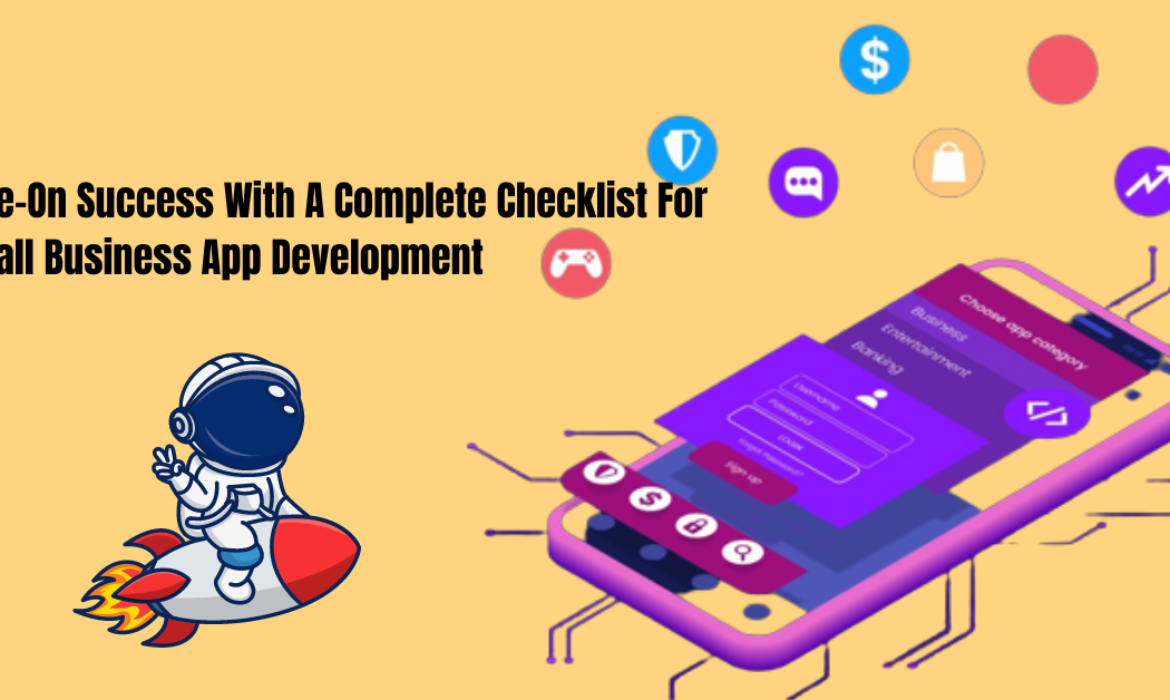
When it comes to user experience, many individuals would choose to use an app rather than a website since apps provide a much superior UX that is tailored to certain goals and viewing habits. With consumers now spending an average of more than 4 hours per day in apps, it’s no surprise that companies want to get a piece of this valuable consumer time.
Entrepreneurs, on the other hand, are often apprehensive about investing in business app development for small businesses, even though the benefits are the same: persistent advertising on people’s phones, easier product/service promotion, offline capabilities, brand recognition, and other advantages.

Going forward in this article, we will go through the checklist for the business app development so that you could curate them in your business app development habits. Let’s begin this detailed guide!
Modern Checklist For Business App Development
1. Keep Your App Easy To Use
If you already have a website, it may be tempting to create a mobile application that is a carbon copy of your website. However, users will only use your software if it offers them something unique and is a more convenient alternative to the one they are now using.
Regardless of how much time individuals spend in applications, the number of people who do so is restricted to roughly 30 per month, thus friction will not be tolerated unless you provide something unique and outstanding.
Another factor to consider is the capacity to provide genuine value. The usage of an app is not everything, nor is it something that can be relied on to significantly improve your company’s performance.
However, it is a very important tool for concentrating on the features that distinguish you from the competition. People like to utilize applications that have a specific goal, which might range from the more apparent shopping to being educated, amused, and being more productive, amongst other activities.
When faced with a plethora of alternatives, people tend to choose programs whose designers were able to prevent over-complication while maintaining a basic UI that adhered to widely recognized standards.
The latter also contributes to the reduction in the cost of app development. The development of mobile applications is frequently a costly and time-consuming endeavor. At the same time, small company owners who approach us with a concept for a mobile application sometimes lack a clear understanding of what they want.
These concerns may get intertwined and result in small firms being unable to take advantage of mobile application prospects. As a result, the more cohesive a plan you have in front of you, the greater the likelihood that the app development process will be efficient.
For an app for small businesses, establish a precise set of objectives that you want to achieve with your app, whether it’s an increase in real sales or an increase in consumer engagement, and stick to them.
2. Focus On User Experience Design
Since improved user experience is one of the key aspects that cause consumers to utilize mobile applications rather than websites, this is something you don’t want to skimp on, no matter how tight your budget may be.
You can consider hiring skilled UI/UX designers who can advise you on how to construct clear and straightforward user flows, which color scheme and typography to use, which areas and features to emphasize and how to do so, and how to take the best from rivals without replicating them.
Personalized mobile applications outperform website-based counterparts in terms of functionality such as notifications and alerts; payment system integration; quicker and simpler checkouts; geolocation capabilities; and social network integration.
When designing and building an application, it is essential to keep all of these considerations in mind, which is not always simple for small company owners who are often required to perform many responsibilities on the development team.
UX designers that develop apps for small businesses are available to assist you, particularly if your company’s business strategy is new to the industry.
3. Develop A Brand
All of these components, from the technical aspects of the app to its physical characteristics, work together to make an app a success. When it comes to App Store Optimization, selecting the most appropriate title, description, images, descriptive video, and a complementary symbol allows people to interact with the brand more simply than they otherwise would.
It is critical to implement the appropriate ASO to make your software stand out in the app store. Apart from being user-friendly, the design should also be visually appealing, with the color pattern and typefaces following the company’s branding criteria. App sample movies that are linked to your landing page are an excellent method to highlight the services you are offering while also enhancing user engagement.
The choice to create an application requires careful planning and decision-making at every level of the development process. The development of the software is a time-consuming and costly process, and one incorrect choice might cause catastrophic harm. This checklist will help you get your app concept off the ground and into the hands of those who will help it reach the success and popularity it deserves.
Not only do consumers and their behavior need extensive study, but so do competitors. If there are no direct analogs in your sector, another piece of advice that might save you thousands of dollars is to see what they have to say about your (possible) rivals or current applications in the same field.
User reviews are a wonderful source of information for small business app development about what your clients are looking for and what other companies are failing to deliver on their promises to them. You may be able to take advantage of the situation by making your offer. Furthermore, you will have the opportunity to do a fairly in-depth examination without devoting an excessive amount of time and money to it.
4. Prioritize MVP
Your app doesn’t need to be very complex. At least for the time being. Depending on your company, developing a Minimum Value Product may assist you in conveying the concept of your app more quickly and at a cheaper cost, while also allowing you to work around the limitations of limited money and small teams that are intrinsic to small enterprises.
Time is money, and time that is not used is money that is not earned. Poor product timing is one of the most prevalent reasons for the failure of goods that would have been successful if they had been released a couple of months earlier, according to research.
MVPs are simple applications with the bare minimum of features and functions that allow you to test working hypotheses and get client feedback in a short period. You may also discover investors based on the MVPs that you create. Aside from that, you may spend years of your life attempting to persuade yourself that a notion is incorrect.
Start with the simplest version of the program to get a feel for it. There is always a point of balance between the timeframe and the quality of work when a development team embarks on a new project. Then, if this version fits your needs, you may go on to a more advanced version.
The method of developing an MVP first for a business app for small businesses is fairly popular and logical; as a result, there are several small company instances that we can point to, even simply from our practice. Apart from developing MVPs, you should know about moving your business to IPO.
5. Stay On Budget
Nothing is free, according to logic and common sense, and saving money on one item will have negative implications on other things later on. Despite this, there are numerous approaches to save money while still producing a high-quality product that has emerged in response to the changing nature of global business procedures.
You may always opt to outsource your app development job to a third-party provider. The technique that includes developing and maintaining an app in-house is only effective if you have a team of technically proficient employees on your team. If this is the case, it is preferable to use outside services to save money while still producing a high-quality product.
Outsourcing allows organizations to save money and time while reaping the benefits of greater knowledge while avoiding the legal and organizational headaches associated with maintaining an in-house workforce.
The downsides of outsourcing for small business mobile app development, such as the possibility of communication issues, are less substantial and may be mitigated by collaborating with an app development business that has extensive expertise in the outsourcing industry.
6. Secure Your Mobile Application
After you decide to create a mobile app for your business, you should consider securing it. Your app will keep a great deal of information about your users as well as information about your firm. As a result, you must place the highest priority on security.
Depending on the sort of app you designed, this information might include sensitive information such as bank account information, credit card information, phone numbers, and other essential data such as social security numbers.
The security of this information is solely your responsibility, and you will be considered a failure by your users if their information is compromised in any manner. In today’s digital world, it would be the end of your development and brand-building careers.
The use of 2-factor authentication and fingerprint lock, among other powerful security features, are among the many choices available to you. It is equally crucial to have backup plans.
7. Search For A Dependable Business Partner
Testimonials are an excellent approach to assess the quality of work that has been completed by a person or firm in the past. At first glance, it may seem challenging, but there is no other guaranteed way to ensure that you will finish up with your ideal app!
As you go through the testimonials, have a look at what prior customers had to say about them by visiting sites like Yelp. This can provide insight into how effectively they were able to execute their promises while also providing some tips based on user comments.
There may be few customer evaluations for a firm since they are new to the market and attempting to create a name for themselves in the industry. The fact that most of their evaluations originate from one or two sources online, such as Clutch, indicates that there are likely some severe integrity concerns with the way these organizations operate in general – something that should raise red signals for any prospective consumer!
8. Select The Most Appropriate Platform For Your Mobile Application
When it comes to business app development, user experience takes precedence over everything, whether it’s for a major corporation or a little company. Making a selection between the platforms of Android, iOS, and Windows becomes more important.
The platform should be chosen based on the geography of your target audience as well as the platform’s dominance in the area in which your audience resides. Native applications are developed for particular platforms, such as Android and iOS, by using native technologies such as Java and Swift.
A native platform-built application has been created and designed exclusively for a mobile operating system or platform. You can choose between React Native and Flutter.
9. Update Regularly
You will need to maintain it in the same way you would any other product, which will include constant improvement. According to expectations, there are financial ramifications connected with these changes, which you should consider in while you’re still developing the app to avoid finding yourself in a financial bind later.
This will enable you to make any necessary adjustments to the app’s functionality during updates, as well as to ensure that your app performs at peak performance at all times.
10. Consider User’s Feedback
Receiving feedback from others is one method to determine whether or not you’re doing a good job, and this is true for your app as well. Additionally, in addition to the feedback you get from beta testers, you may solicit the opinions of other developers on the work you’ve completed.
It would give you an impartial expert study that you may not be able to do on your timetable or budget. Because you and the developer have different working styles, the developer may approach the problem from a completely new perspective, which may reveal something you had overlooked or a feature that might be enhanced.
Best Features To Implement During Business App Development
Some of the most popular app features that you could implement during business app development are:
1. VR Support
Ever tried to persuade someone that a black leather couch would look fantastic in his or her living room? If you have, this guide will help you. or maybe to demonstrate to a client how she would seem with a fresh and different hairstyle? These interactive elements have proven to be a powerful marketing tool and a method of increasing customer engagement for several firms.
2. Push Notifications
This is one of the most significant app features since it allows for timely, suitable, on-demand communication that does not get caught in a SPAM filter, which is one of the most common problems. Push notifications, when paired with location-based messaging, may provide a more customized experience for the user.
3. Loyalty Programmes
Customer loyalty programs should be maintained via a mobile application so that consumers can easily earn points, manage them, and redeem them using a mobile device.
4. Integration Of Geolocation
Identify the precise location of your consumers and offer them clear information on how they may reach you. Employ rewards or vouchers that are exclusive to a place, or notify your personnel anytime a VIP client visits your business.
5. Stripe Payments
The ability to make it as easy as possible for your customers to browse for and purchase your goods and services is an absolute must-have feature for any mobile application.
6. Single Touch Contact
This should go without saying, but keep in mind and learn to include all of your contact information, including emails, social media profiles, and one-click phoning. Why not provide step-by-step instructions that can be added with a single tap?
7. Social Media Integration
Integrate all of your social media platforms and make it easy for your customers to connect and interact with you on Twitter, Facebook, Pinterest, and other social media platforms, according to the company.
8. Smart Update & Sync
Using your mobile app, you can automatically sync content and push changes across all of your digital platforms.
Perfect Your Business App Development
The choice to create an application requires careful planning and decision-making at every level of the development process. The development of the software is a time-consuming and costly process, and one incorrect choice might cause catastrophic harm.
Our checklist of business app development will help you get your app concept off the ground and into the hands of those who will help it reach the success and popularity it deserves.



